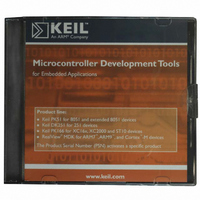MDK-ARM Keil, MDK-ARM Datasheet - Page 112

MDK-ARM
Manufacturer Part Number
MDK-ARM
Description
KIT REALVIEW MCU DEVELOPMENT
Manufacturer
Keil
Type
Compiler and IDEr
Specifications of MDK-ARM
For Use With/related Products
ARM MCUs
Lead Free Status / RoHS Status
Lead free / RoHS Compliant
- Current page: 112 of 156
- Download datasheet (3Mb)
112
Chapter 5. RL-USB Introduction
The physical USB network is implemented as a tiered star network. The USB
host provides one attachment port for an external USB peripheral. If more than
one peripheral is required, connect a hub to the root port and the hub will provide
additional connection ports. For a large number of USB peripherals add further
hubs to provide the ports needed. The USB network can support up to 127
external nodes (hubs
and devices). It
supports six tiers of
hubs and requires one
bus master.
Each hub or device
may be self-powered
or bus-powered. If a
device is bus-powered,
it can consume a
maximum of 500mA at
5V.
Logical Network
To the developer the logical USB network appears as a star network. The hub
components do not introduce any programming complexity and are essentially
transparent as far as the programmer is concerned. Therefore, if you develop a
USB device by connecting it to a root port on the host, the same device will work
when connected to the host via several intermediate hubs.
To the programmer the USB
network appears as a star
network with the host at the
centre. All the USB devices are
available as addressable nodes.
The other key feature of the
USB network is that it is a
master/slave network. The USB
host is in control. On the
network, this is the only device
that can initiate a data transfer.
Related parts for MDK-ARM
Image
Part Number
Description
Manufacturer
Datasheet
Request
R

Part Number:
Description:
KIT REALVIEW MCU DEVELOPMENT
Manufacturer:
Keil
Datasheet:

Part Number:
Description:
Development Software SUPPORT EXTENSION FOR MDK-ARM-B
Manufacturer:
Keil Software

Part Number:
Description:
Development Software SUPPORT EXTENSION FOR MDK-ARM
Manufacturer:
Keil Software

Part Number:
Description:
KIT REALVIEW MCU DEVELOPMENT
Manufacturer:
Keil
Datasheet:

Part Number:
Description:
Development Software MCU DEV KIT FOR ARM UPG TO FLOATING LIC
Manufacturer:
Keil Tools

Part Number:
Description:
Development Software MCU DEV KIT FOR ARM W/ FLOATING LICENSE
Manufacturer:
Keil Software

Part Number:
Description:
Development Software MCU DEV KIT FOR ARM uVISION & C++ & RTX
Manufacturer:
Keil Tools

Part Number:
Description:
Development Software SUPP LICENSE RENEWAL 90+ DAYS NO TECH SUP
Manufacturer:
Keil Software
Part Number:
Description:
KEIL C-COMPILER INTERNATIONAL
Manufacturer:
Silicon Laboratories Inc

Part Number:
Description:
BOARD EVAL FOR LPC213X ARM MCU
Manufacturer:
NXP Semiconductors
Datasheet:
Part Number:
Description:
K60N512 Keil Tower Kit
Manufacturer:
Freescale Semiconductor
Datasheet:










